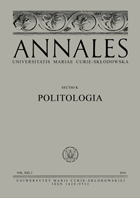Direct Democracy in France and Poland. A Comparative Analysis
Direct Democracy in France and Poland. A Comparative Analysis
Author(s): Maria Marczewska-RytkoSubject(s): Governance, Politics and society, Comparative politics
Published by: Wydawnictwo Naukowe Uniwersytetu Marii Curie-Sklodowskiej
Keywords: direct democracy; referendum; France; Poland;
Summary/Abstract: The aim of this article is to conduct a comparative analysis of direct democracy in France and Poland. In the research process, three research questions were formulated: 1) What is the tradition of direct democracy in France and Poland?; 2) What are the solutions characteristics of direct democracy in the constitutions of France and Poland, and other legal acts in these countries?; 3) What are the practical applications of direct democracy tools at the national and local levels in France and Poland?. An analysis of legal acts constituting the legal basis for direct democracy in France and Poland was conducted. Documents related to the practice of direct democracy in these countries were analyzed. France has a long tradition of a direct democracy. Compared to France, Poland has a short tradition of direct democracy. The constitutions of both countries adopted a solution in the form of a national referendum. In addition to the institution of a nationwide referendum, the constitution-makers in France and Poland included the institution of a local referendum. The Constitution of the Republic of Poland also indicates a legislative initiative. Ten national referenda have been held within the Fifth Republic. Turnouts in referendums at the national level ranged from 30.19 to 82.63%. The average turnout in the referendum is 65.82%. In the votes, eight solutions were adopted and two were rejected. Six national referendums have been held in Poland since 1989. Turnouts in referendums at the national level ranged from 7.8 to 58.85%. The average turnout in referendums was 35.87%. Two solutions were adopted in the votes and four were rejected.
Journal: Annales Universitatis Mariae Curie-Skłodowska, sectio K – Politologia
- Issue Year: 30/2023
- Issue No: 2
- Page Range: 7-31
- Page Count: 25
- Language: English

